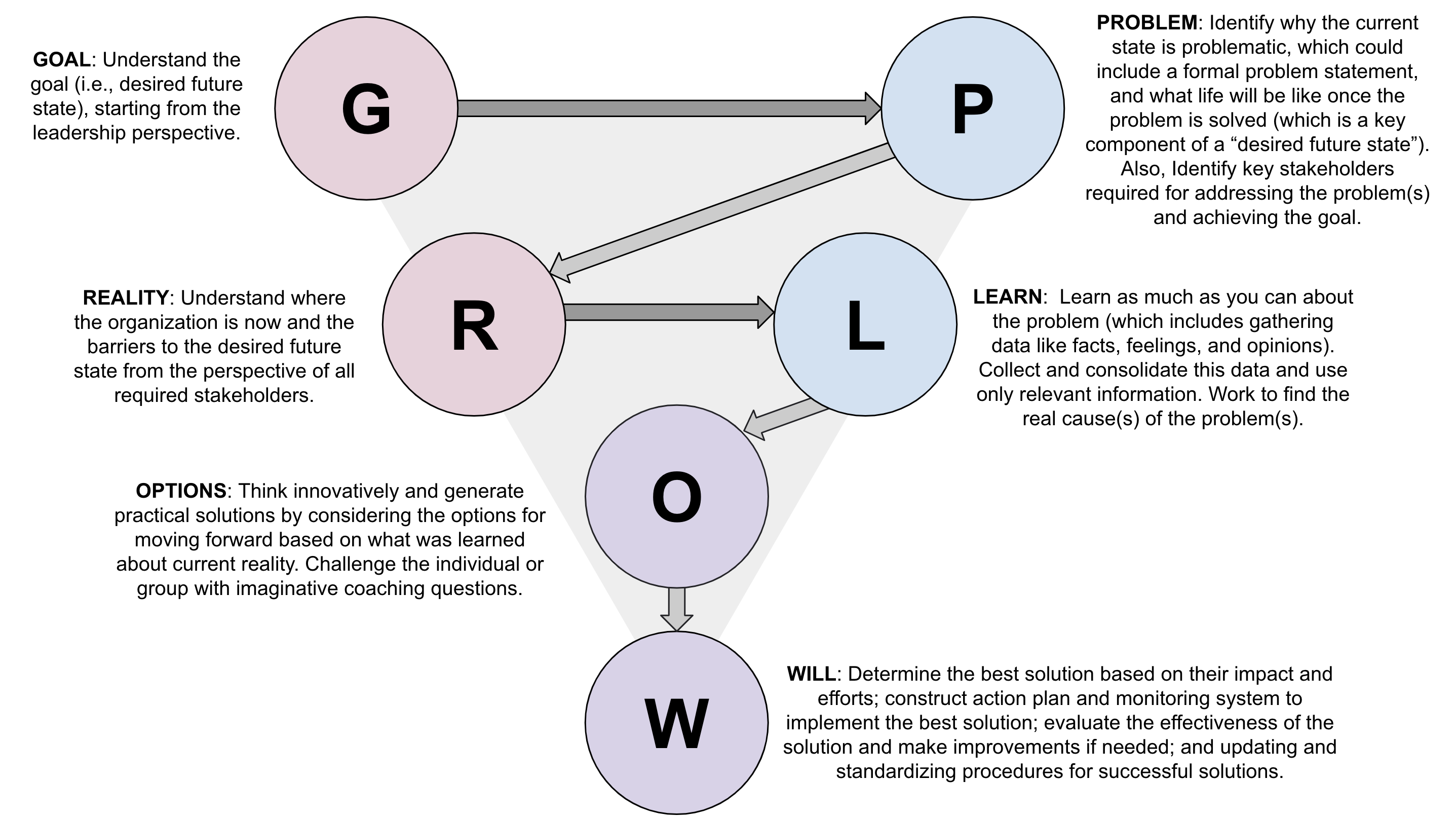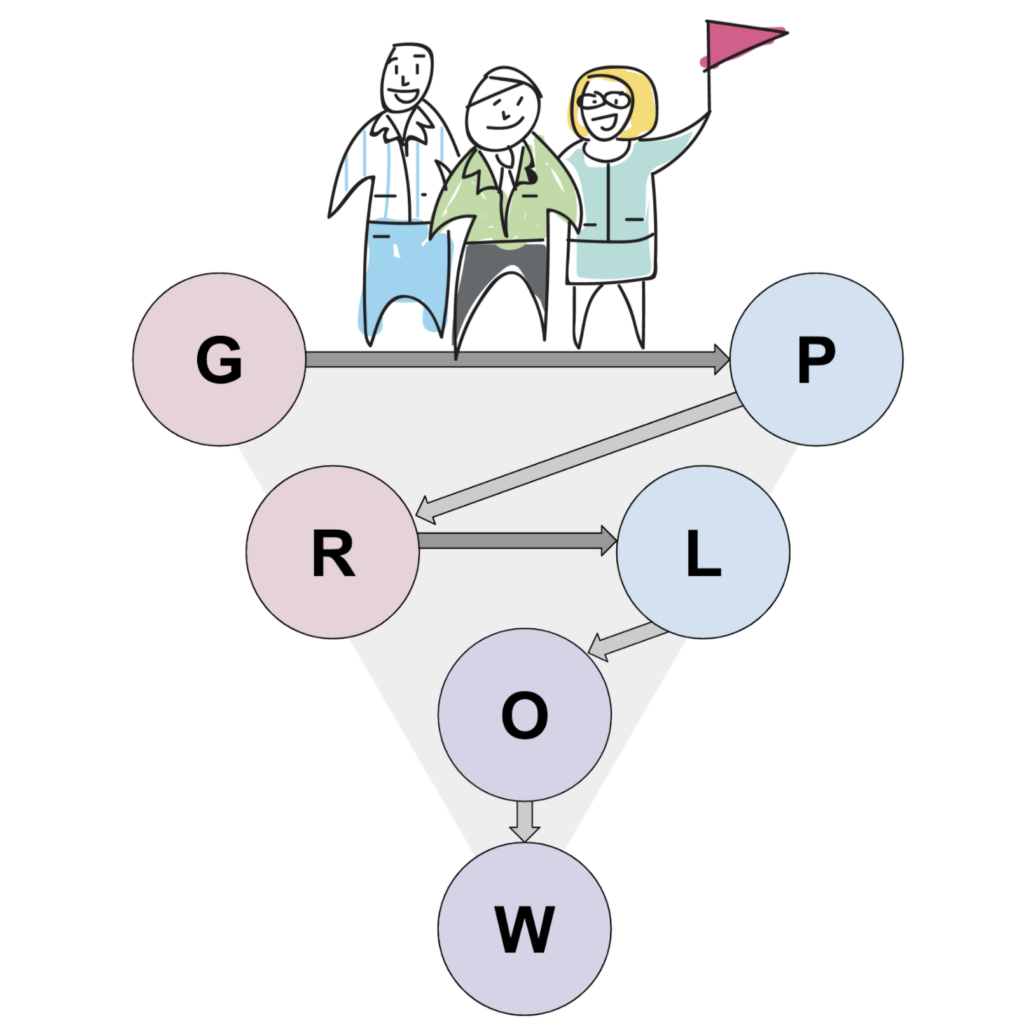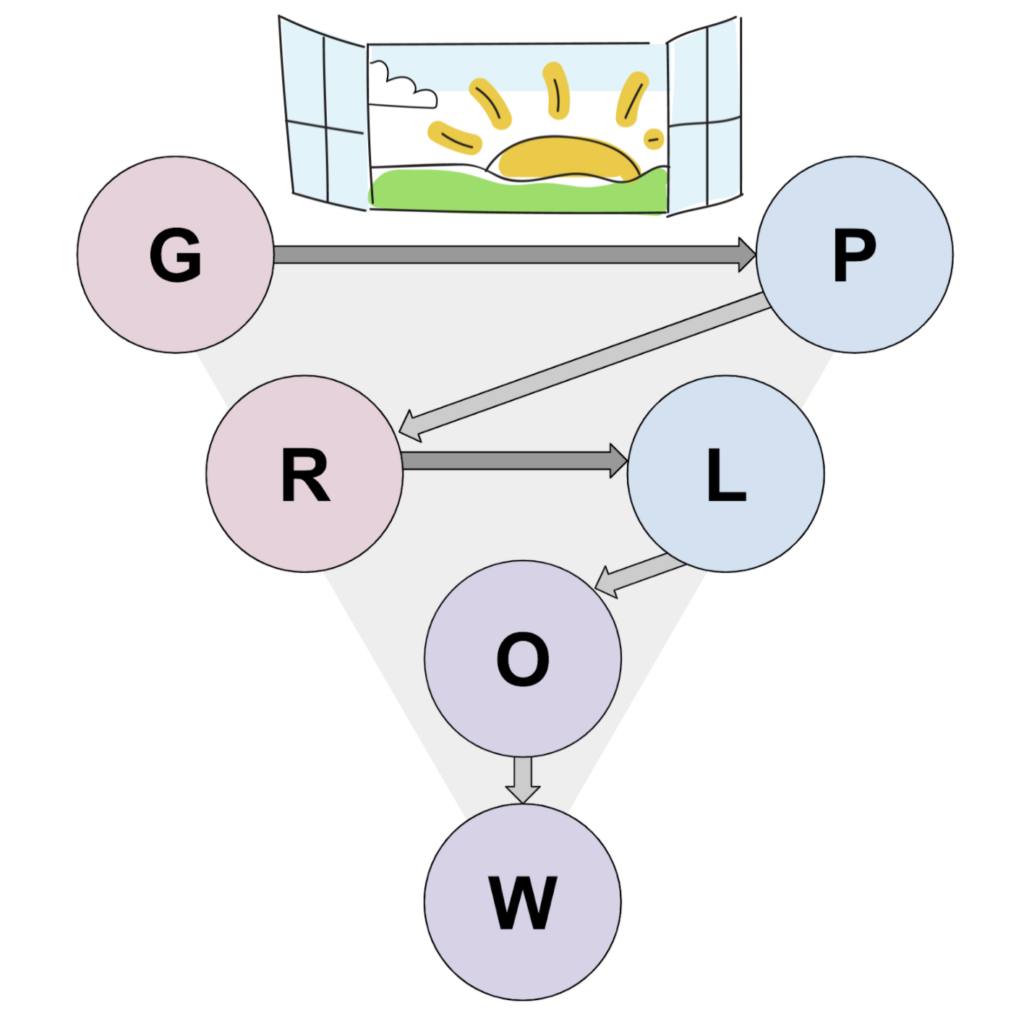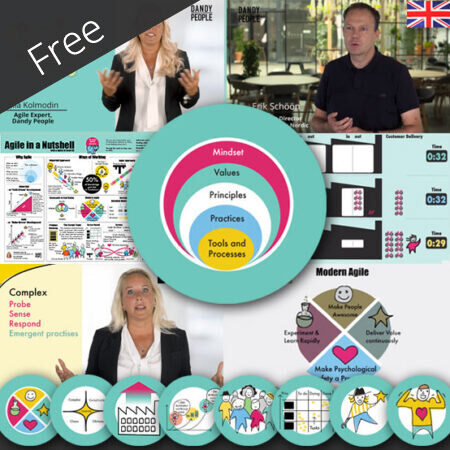In this blog post, we present a case study using the model designed to leverage the processing strengths and mobilize the brainpower of today’s entire (organizational) collective, which we’re currently calling the Grow/Plow Coaching Model. We have previously published a post on the Grow/Plow model that you can find here if you havent read it.
The Grow/Plow Coaching Model
As you can see on the graphic below, GROW and PLOW naturally overlap at the O and W. PLOW supplements GROW so bottom-up thinking could be integrated into a single coaching model we’re calling the Grow/Plow Coaching Model:

You may notice that the conversation does start with the Goal, irrespective of processing styles. That is because it’s a helpful question to ask at the beginning of the coaching conversation because it lets the coach know whether or not there’s already a well-articulated desired future state to work towards.
Learn more about the Grow/Plow coaching model in this blogpost previously posted on our blog >
The Grow/Plow Coaching model in practice
When no desired future state can be articulated at the onset, the coach can help the coachee articulate one during the “P” stage where a problem statement is defined by exploring why the status quo is no longer working and then used to articulate “what life will look like once that problem is solved” (which is a desired future state). This approach may strike you as inherently negative, which is intentional. The human brain is biologically predisposed toward registering negative stimuli more readily and also dwelling on these events. This psychological phenomenon explains why it’s so much easier for clients to articulate their problems rather than goals and aspirations. As a coach, the goal is to leverage this energy just long enough to flip the conversation into exploring what life could look like without the problems.
You may also notice that many great coaches naturally follow this process and thereby find success when coaching clients of all processing styles. This is true and absolutely fantastic. The reason we wanted to be intentional about laying out an overt process is so more coaches can be aware of diverse processing styles and give them tactics that could be helpful.
See the most recent case study below for a concrete example of how we’ve used the Grow/Plow Coaching Model in an organizational setting (where it can be easily scaled to individual settings). We included “Coach Notes” for additional details that may interest coaches who are reading this blog post.

The Case Study

We started this assignment as Agile Coaches who were to be embedded with the Change Leadership Team within a particular organization (that was part of a larger enterprise). Through our initial interviews, we learned that there were over 18 concurrent initiatives without any clearly defined, overarching (or compelling) goal apart from the battle cry of “we need to change ” based on an organizational analysis performed by a big name consultancy. We learned multiple examples of how the current system “is not working” without any meaningful goal or concrete future state that could align and compel people to move forward together.
Coach Notes: This is a classic case of high-level execs having a very vaguely defined goal and then putting pressure on lower leaders to deliver on a goal they can’t relate to and didn’t create. What results are many concurrent and potentially unrelated activities that may or may not move the needle in any meaningful direction, where no one typically stops to think about what desired future state they’d like to move towards (on business or team level). They often need help connecting the dots between everyday work and activities and big-picture goals and aspirations (whether or not they make them or someone else makes them).

We started by inviting the leaders to (1) articulate the business problem that the multiple initiatives were meant to solve using Agile approaches, and (2) identify which stakeholders would be critical for solving the problem. The conversation focuses on extracting details that could come together to form a problem statement that creates focus and generates creative problem-solving. We had a concrete problem articulated by the end of the session, which was regarding the operational risk that’s introduced when developers don’t deliver “the right solution at the right time” according to internal and external customers. This was a powerful start.
Coach Notes: These leaders struggled to make the connection between the big picture goals and concrete reality. This activity helped them to start making the connection and create a conceptual map linking the executive’s goals, the vision statement of their part of the organization, and the business problem they’re trying to solve (that will help them achieve their executive’s goals AND arrive at their vision). Moreover, this problem statement was the start of making abstract business goals concrete enough for the system thinkers at the operational levels to get the context they need to more easily contribute.

We learned in the second month of our assignment that some of the leaders had created an idealized version of a Software Development Life Cycle (SDLC) that they wanted to immediately implement as part of the multiple initiatives to ensure the right solutions were delivered at the right time. We immediately recognized this as a concrete articulate of a “desired future state” and invited the stakeholders previously identified to identify the barriers and obstacles that could hold us back from successfully arriving at this desired future state. The conversations naturally led to multiple sessions with operational-level stakeholders and a value stream mapping to ensure an alignment between systemic and architectural constraints and the desired future state. What emerged was a more realistic SDLC that was co-created by the stakeholders and blessed by the leadership.
Coach Notes: This activity had two powerful outcomes. First of all, it helped the leaders understand the reality at the operational level instead of viewing the SDLC as a theoretic construct that could be altered at will. We needed them to have this reality check. Second of all, it invited the systemic thinkers at the operational and supervisory levels to contribute with their detailed understanding of current reality. Hinders that leadership did not see were surfaced and analyzed through our sessions, which informed the proposed SDLC design and uncovered additional data regarding how processes really were happening on a day-to-day level. Moreover, it was very interesting to see how some concrete, systemic thinkers even struggled to conceptualize the proposed SDLC. They needed to work through examples that included templates in Jira.

We also focused on learning more about the overarching problem itself, i.e., not delivering the right solutions at the right time, as well as the barriers and obstacles surfaced at the operational and supervisory levels in both the delivery and product teams. We got great data, which included critical organizational capability gaps and needed role clarification. The result was clarity along with the natural merging together of various initiatives from over twelve down to three and then finally down to one (as described below). We also used this data to help create the organization’s first-ever OKR set.
Coach Notes: We invited various stakeholders from the operational and supervisory levels to join us on this learning quest whenever it impacted their purview and/or area(s) of expertise or interest. There was wonderful engagement, enthusiasm, and trust build during these meetings that ranged from formal Miro sessions to informal direct messaging chats. We grew to understand the world as they saw it and how their behaviors and decisions could be misunderstood by those at senior levels in the organization. Important feedback loops started as we began linking the people and information we were encountering with those higher in the organization so the right information and resources could be flowing at the right time to ensure that the right solutions could be delivered at the right time. We really were getting to PLOW the ground so the organization could GROW!

What emerged from the data was very clearly a need for decoupling the product and delivery cadences along with localized role and expectation clarity throughout the teams.
Coach Notes: We uncovered so much data by this point that we all could see the most natural option was the one we landed upon (below), which was similar to the Scrum@Scale model tweaked to include the aforementioned SDLC. Given that we arrived at this conclusion through consideration of multiple data points derived from multiple perspectives, all processing styles were accounted for.

The solution that emerged from the data was similar to the Scrum@Scale model that was enhanced by the co-created SDLC and localized role and expectations. All the previously decoupled initiatives could now be seen as part of this larger Scrum@Scale. In 5-months we moved from over 18 concurrent initiatives to 1 initiative with a collection of closely related sub-initiatives. We were super excited and are currently working through a calendar of launches that simply build upon, and complement, the 5-months of collaborative work we started with the teams at all levels.
Coach Notes: LESSONS LEARNED – We could have benefitted from having this model explicitly visualized at the start of our assignment so that leadership could have better understood the coaching journey, and how it’s different than consulting. There were multiple times we needed to probe and address expectations when leaders wanted us to simply “install a blueprint” for change rather than collaborate to define what the change is, what the change means, and how we’ll get there together.

CONCLUSION
When it comes to an organization of different processing styles or even at an individual level, we believe that in order to GROW there must be a willingness to PLOW. In farming, plowing turns up the soil and prepares it for seeding. In organizational coaching, combining PLOW with GROW prepares the organization for the seeds of change by breaking up clumps of outdated knowledge and behaviors, revealing what’s under the surface, and bringing up fresh nutrients.
In an upcoming blog post, we’ll be examining research-based principles that form the keys to success when using the Grow/Plow Coaching model. The principles come from the field of research called Organizational Mindfulness and the study of High-Reliability Organizations (HROs), as well as the rules that govern effective herds.
We’d love to hear about your experience with coaching to leverage the processing styles of your creative and innovative talent. Please do leave your comments and questions below!
Learn more about the Grow/Plow coaching model in this blogpost previously posted on our blog >


